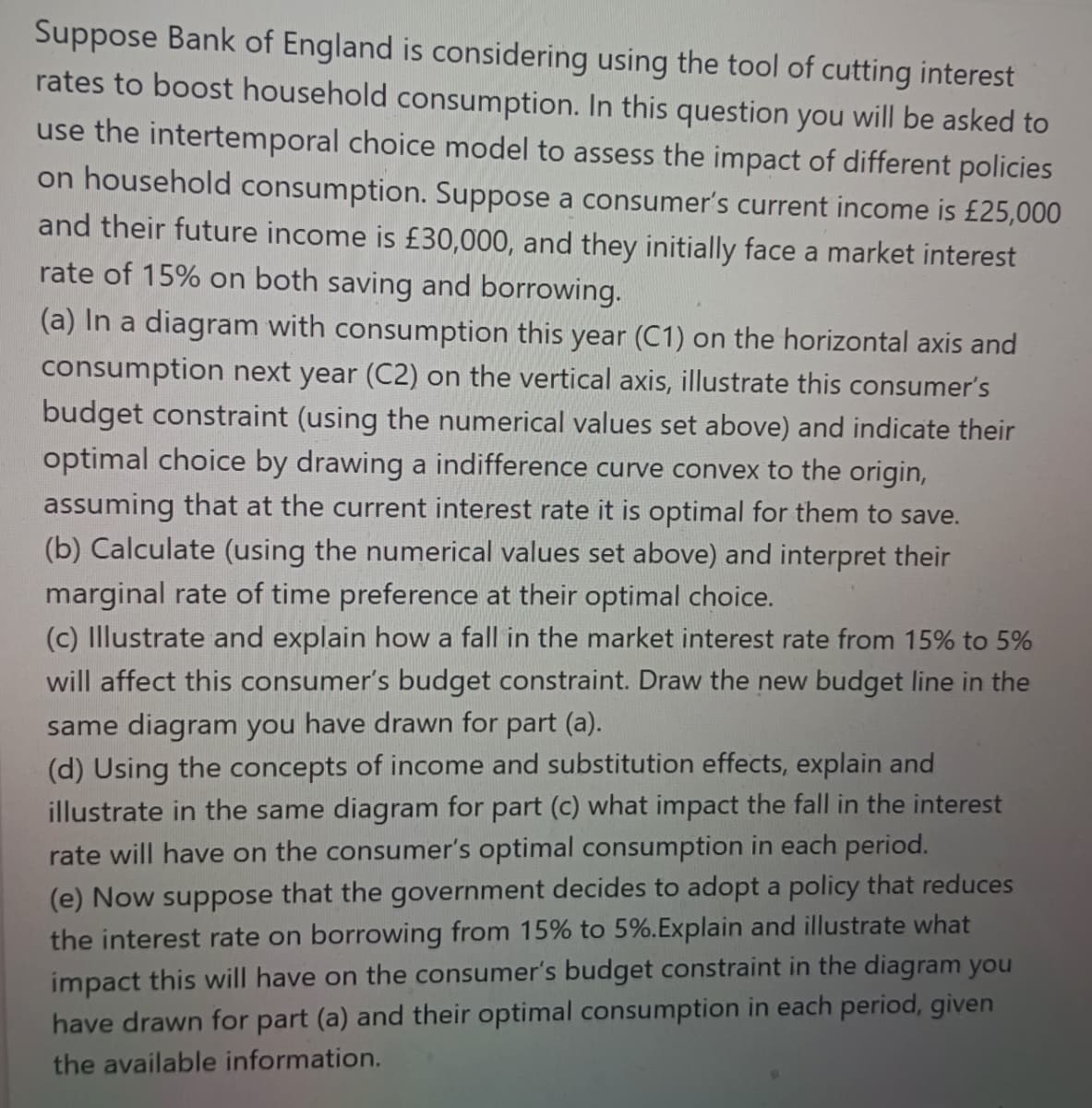Suppose Bank of England is considering using the tool of cutting interest rates to boost household consumption. In this question you will be asked to use the intertemporal choice model to assess the impact of different policies on household consumption. Suppose a consumer's current income is £25,000 and their future income is £30,000, and they initially face a market interest rate of 15% on both saving and borrowing. (a) In a diagram with consumption this year (C1) on the horizontal axis and consumption next year (C2) on the vertical axis, illustrate this consumer's budget constraint (using the numerical values set above) and indicate their optimal choice by drawing a indifference curve convex to the origin, assuming that at the current interest rate it is optimal for them to save. (b) Calculate (using the numerical values set above) and interpret their marginal rate of time preference at their optimal choice. (c) Illustrate and explain how a fall in the market interest rate from 15% to 5% will affect this consumer's budget constraint. Draw the new budget line in the same diagram you have drawn for part (a). (d) Using the concepts of income and substitution effects, explain and illustrate in the same diagram for part (c) what impact the fall in the interest rate will have on the consumer's optimal consumption in each period. (e) Now suppose that the government decides to adopt a policy that reduces the interest rate on borrowing from 15% to 5%. Explain and illustrate what impact this will have on the consumer's budget constraint in the diagram you have drawn for part (a) and their optimal consumption in each period, given the available information.
Suppose Bank of England is considering using the tool of cutting interest rates to boost household consumption. In this question you will be asked to use the intertemporal choice model to assess the impact of different policies on household consumption. Suppose a consumer's current income is £25,000 and their future income is £30,000, and they initially face a market interest rate of 15% on both saving and borrowing. (a) In a diagram with consumption this year (C1) on the horizontal axis and consumption next year (C2) on the vertical axis, illustrate this consumer's budget constraint (using the numerical values set above) and indicate their optimal choice by drawing a indifference curve convex to the origin, assuming that at the current interest rate it is optimal for them to save. (b) Calculate (using the numerical values set above) and interpret their marginal rate of time preference at their optimal choice. (c) Illustrate and explain how a fall in the market interest rate from 15% to 5% will affect this consumer's budget constraint. Draw the new budget line in the same diagram you have drawn for part (a). (d) Using the concepts of income and substitution effects, explain and illustrate in the same diagram for part (c) what impact the fall in the interest rate will have on the consumer's optimal consumption in each period. (e) Now suppose that the government decides to adopt a policy that reduces the interest rate on borrowing from 15% to 5%. Explain and illustrate what impact this will have on the consumer's budget constraint in the diagram you have drawn for part (a) and their optimal consumption in each period, given the available information.
Chapter2: Mathematics For Microeconomics
Section: Chapter Questions
Problem 2.3P
Related questions
Question
please answer the microeconomics questions below, thanks

Transcribed Image Text:Suppose Bank of England is considering using the tool of cutting interest
rates to boost household consumption. In this question you will be asked to
use the intertemporal choice model to assess the impact of different policies
on household consumption. Suppose a consumer's current income is £25,000
and their future income is £30,000, and they initially face a market interest
rate of 15% on both saving and borrowing.
(a) In a diagram with consumption this year (C1) on the horizontal axis and
consumption next year (C2) on the vertical axis, illustrate this consumer's
budget constraint (using the numerical values set above) and indicate their
optimal choice by drawing a indifference curve convex to the origin,
assuming that at the current interest rate it is optimal for them to save.
(b) Calculate (using the numerical values set above) and interpret their
marginal rate of time preference at their optimal choice.
(c) Illustrate and explain how a fall in the market interest rate from 15% to 5%
will affect this consumer's budget constraint. Draw the new budget line in the
same diagram you have drawn for part (a).
(d) Using the concepts of income and substitution effects, explain and
illustrate in the same diagram for part
what impact the fall in the interest
rate will have on the consumer's optimal consumption in each period.
(e) Now suppose that the government decides to adopt a policy that reduces
the interest rate on borrowing from 15% to 5%.Explain and illustrate what
impact this will have on the consumer's budget constraint in the diagram you
have drawn for part (a) and their optimal consumption in each period, given
the available information.
Expert Solution
This question has been solved!
Explore an expertly crafted, step-by-step solution for a thorough understanding of key concepts.
Step by step
Solved in 3 steps with 2 images

Knowledge Booster
Learn more about
Need a deep-dive on the concept behind this application? Look no further. Learn more about this topic, economics and related others by exploring similar questions and additional content below.Recommended textbooks for you

